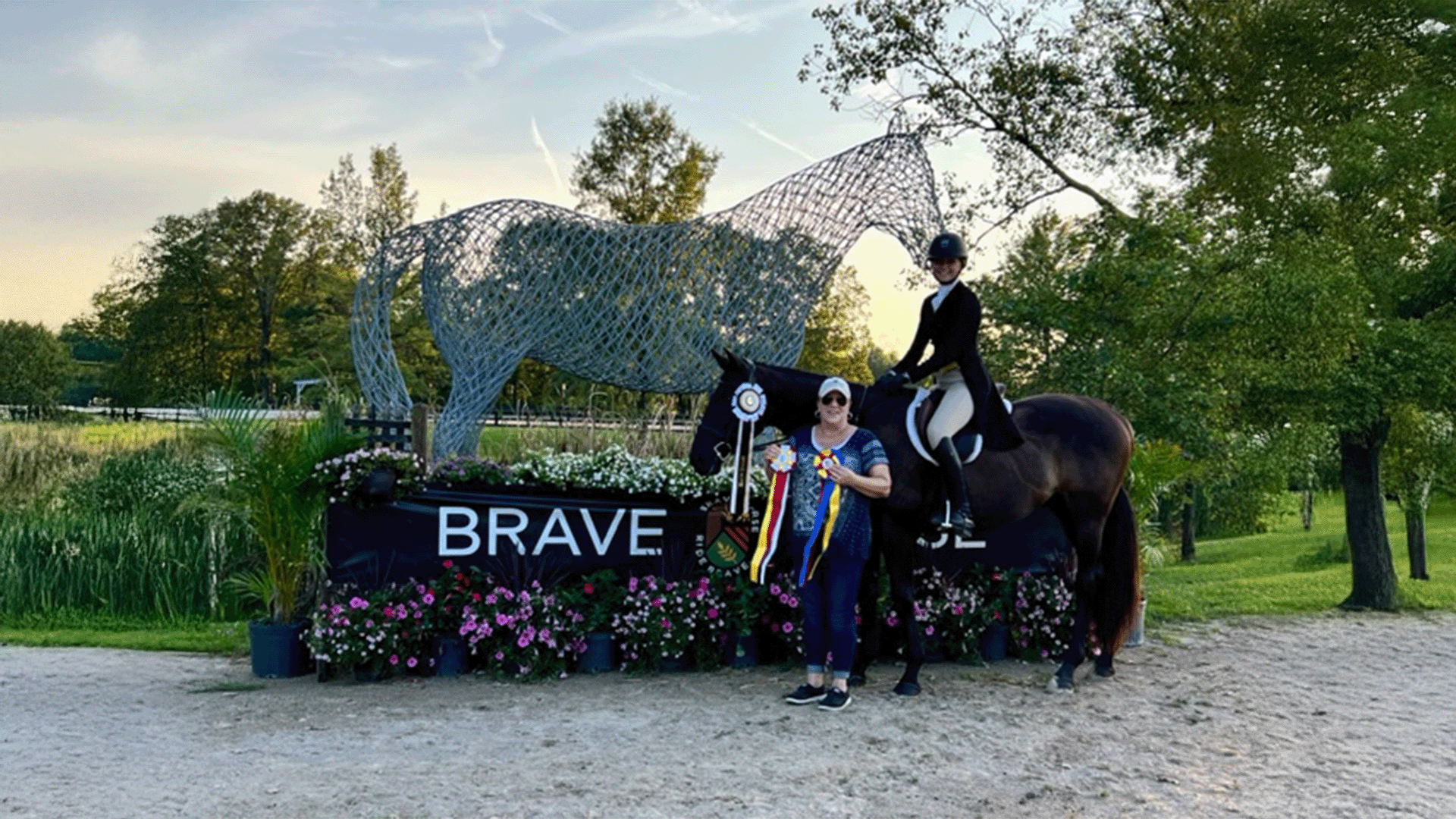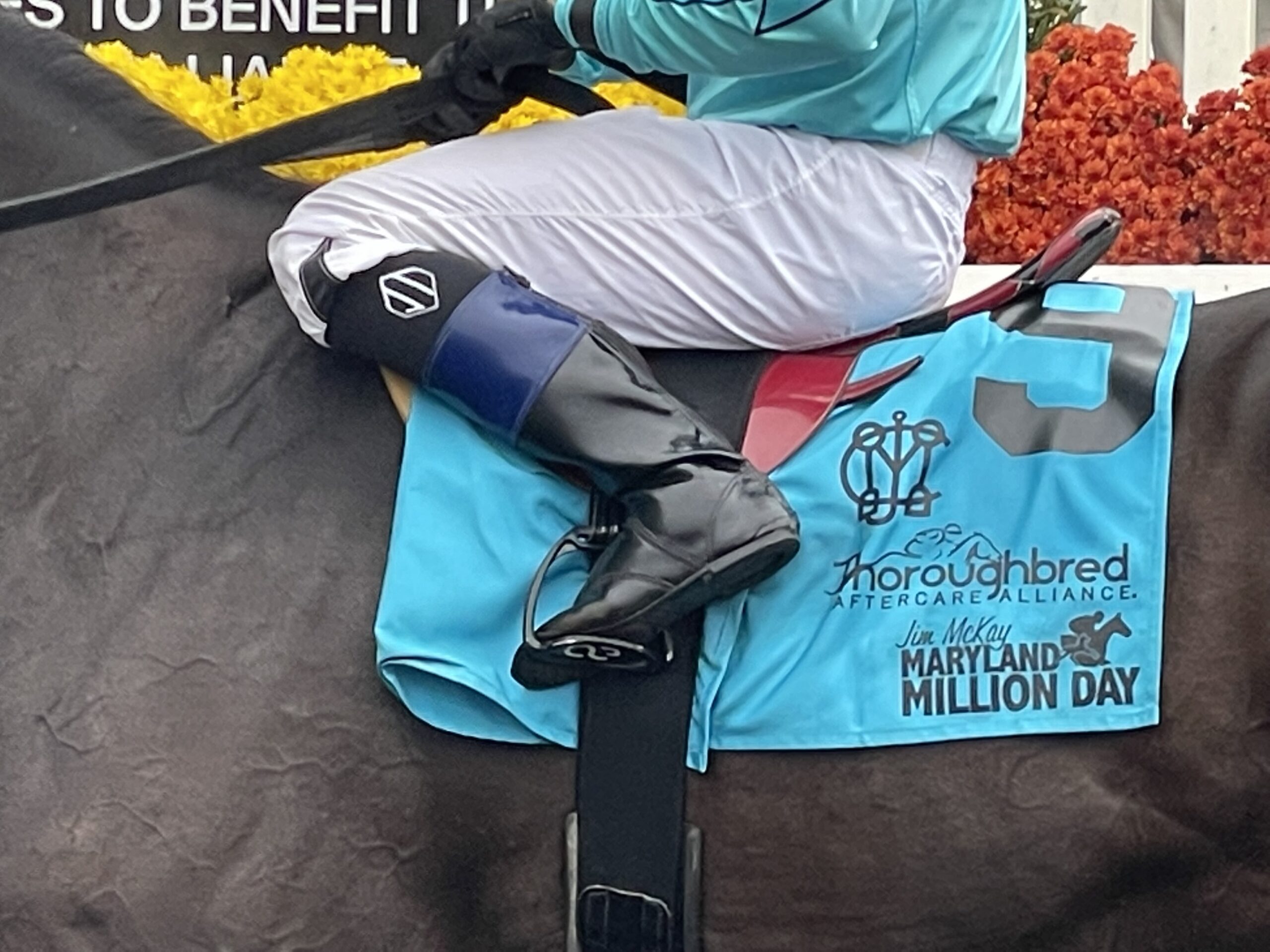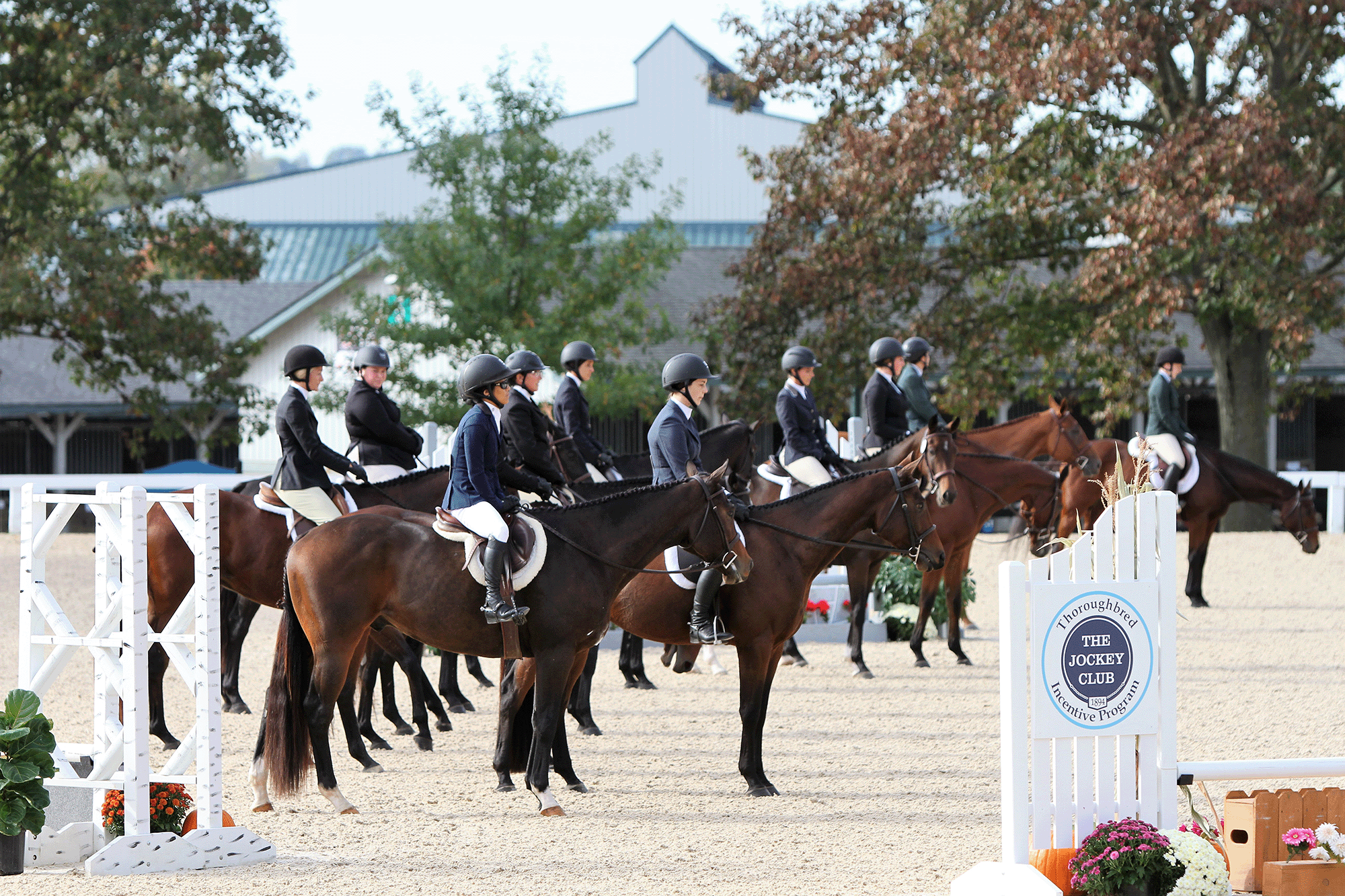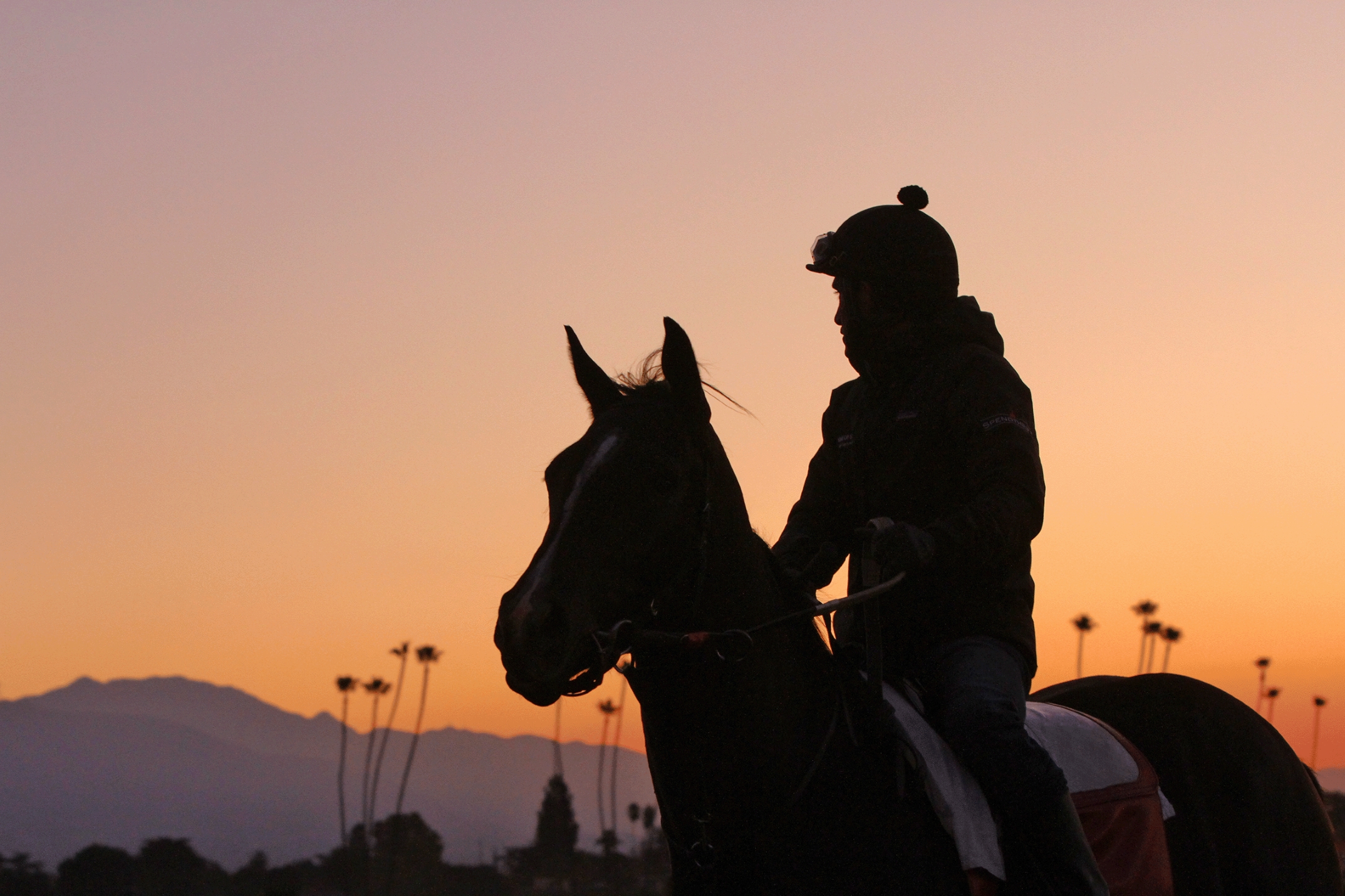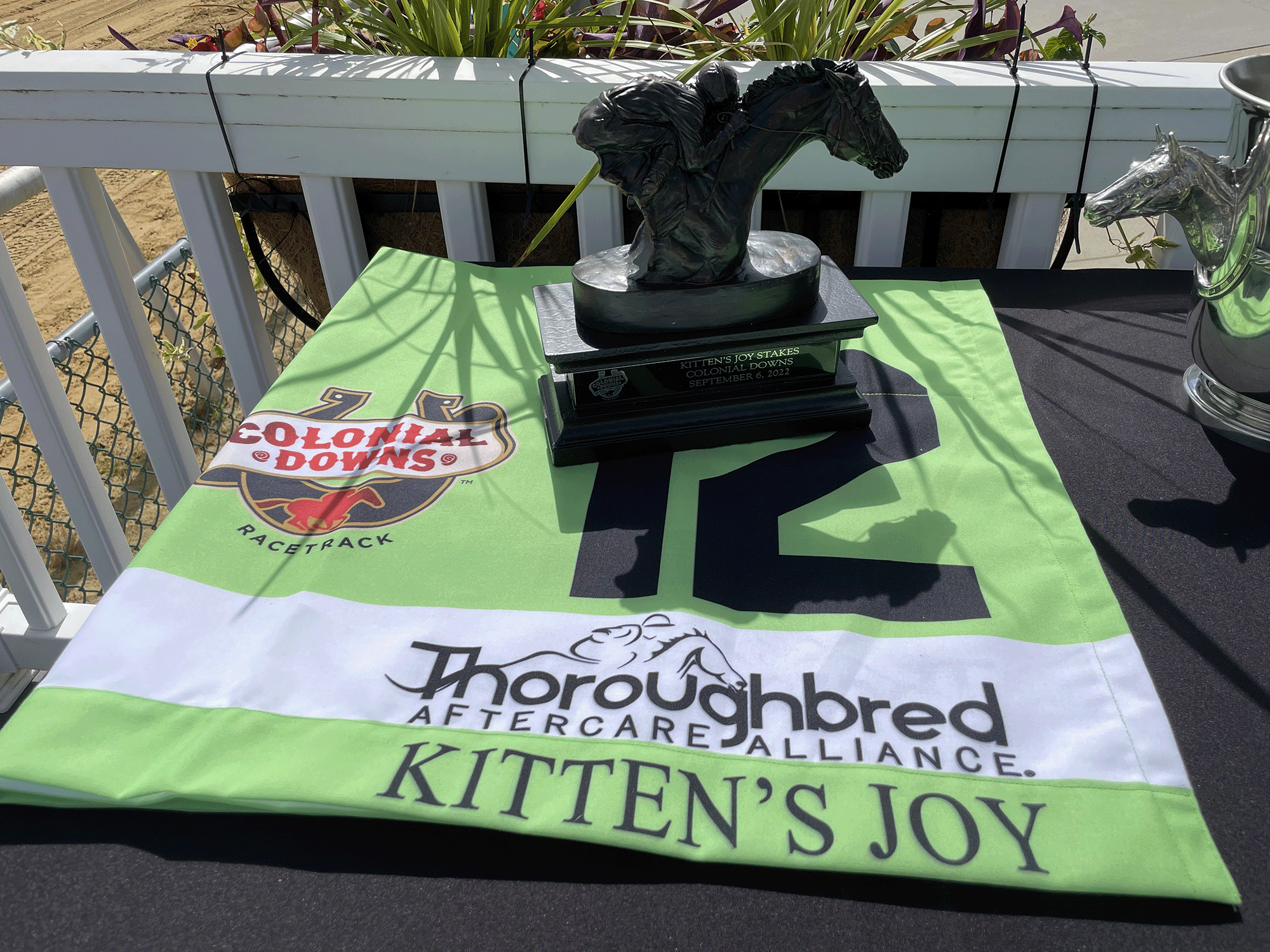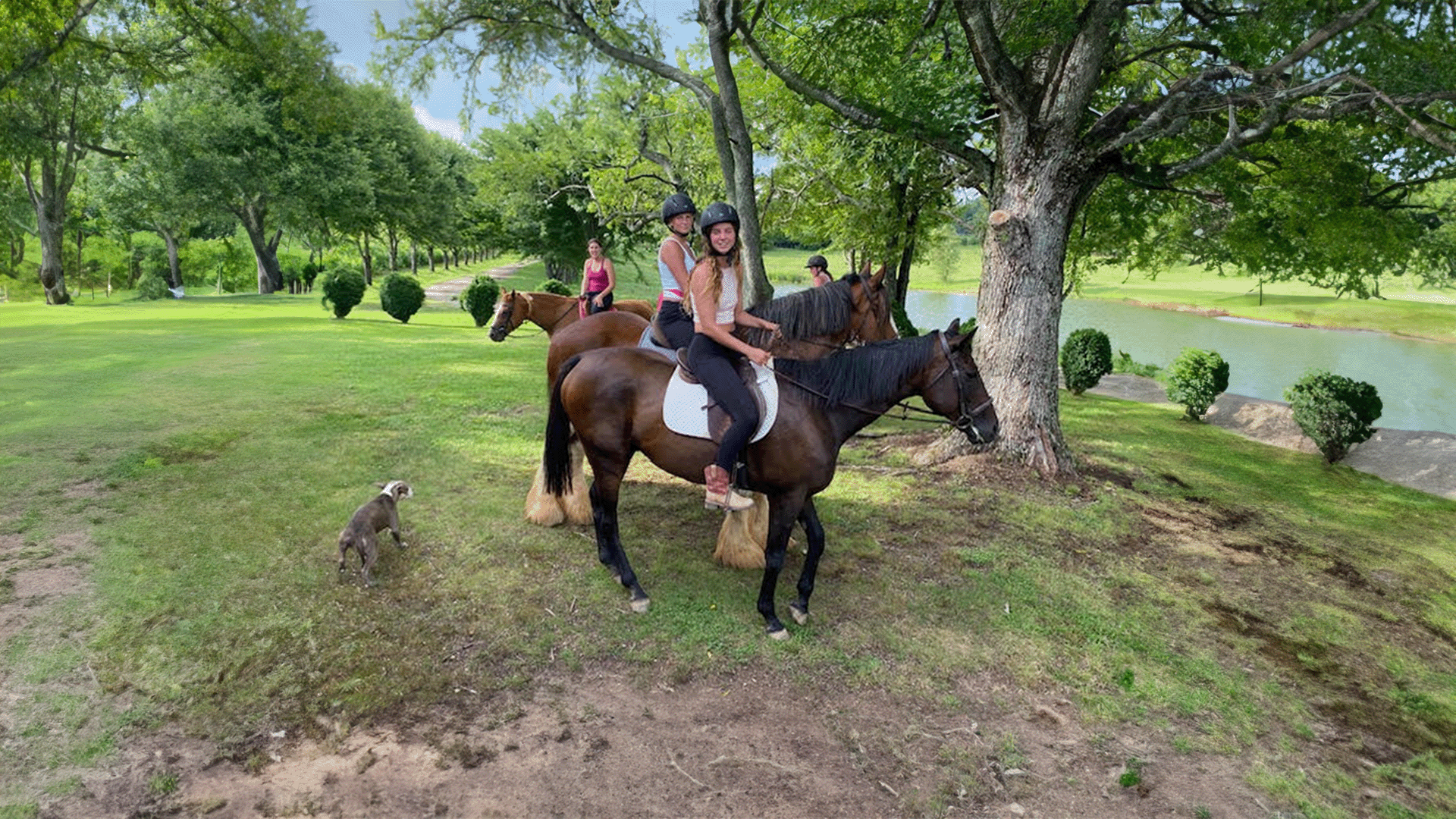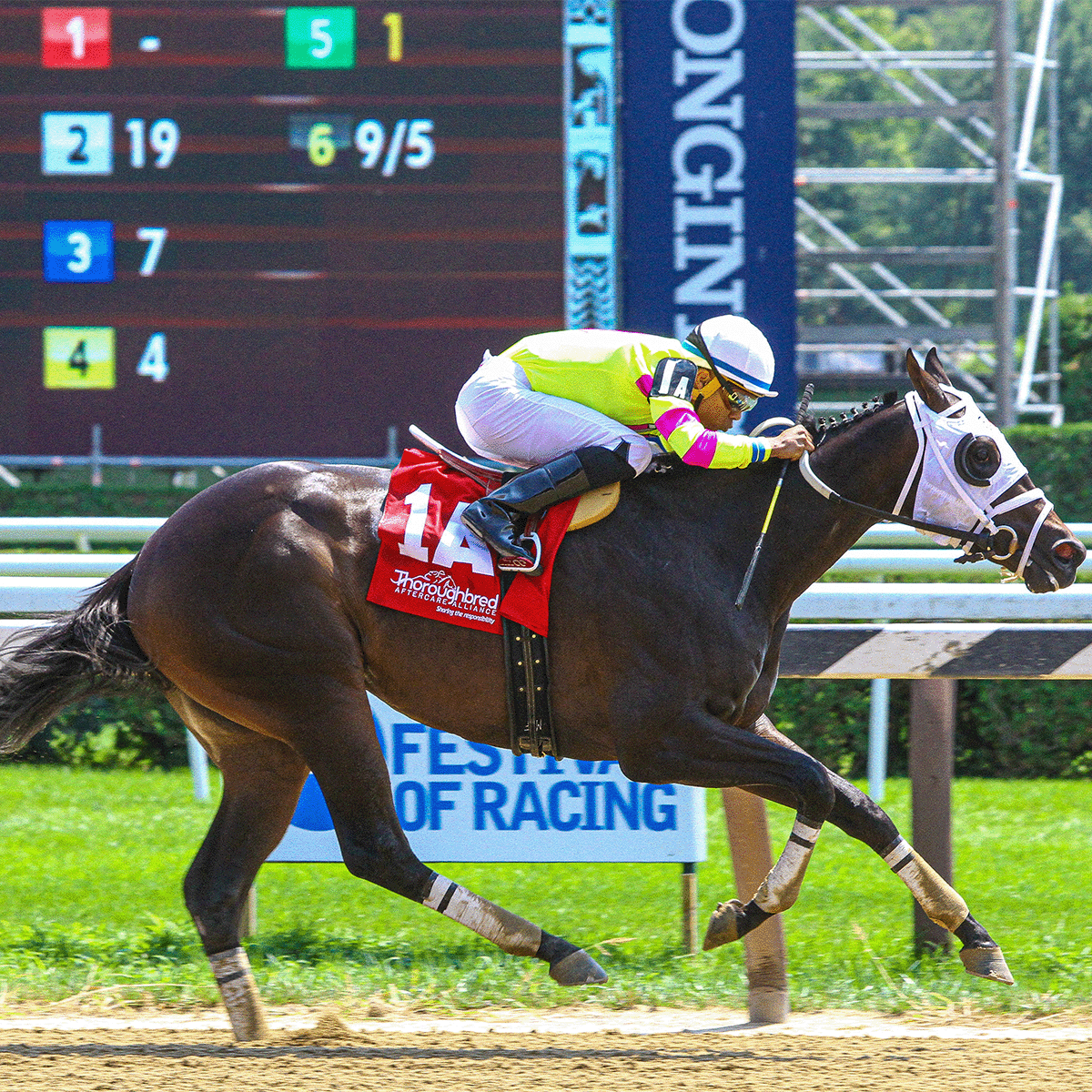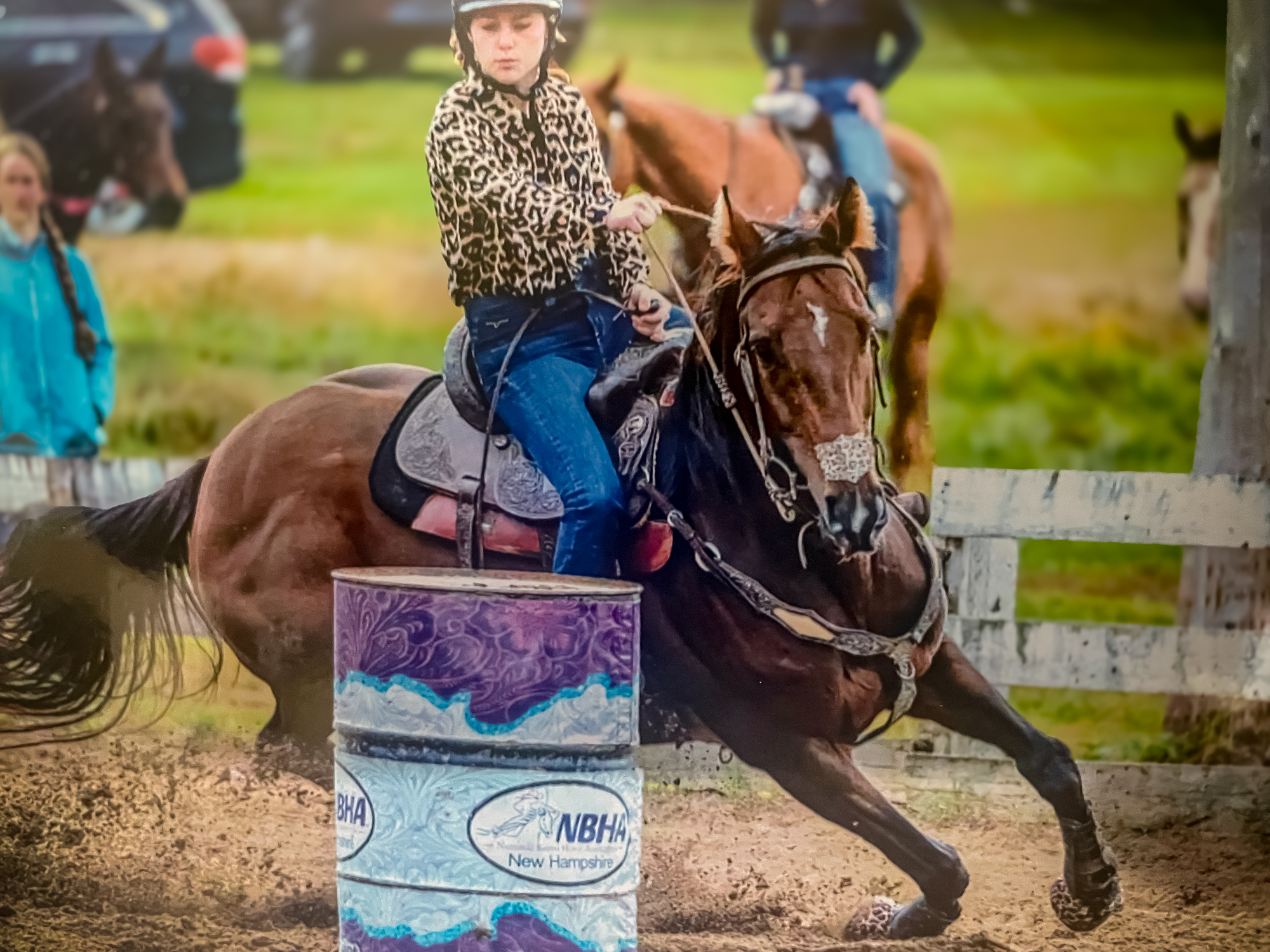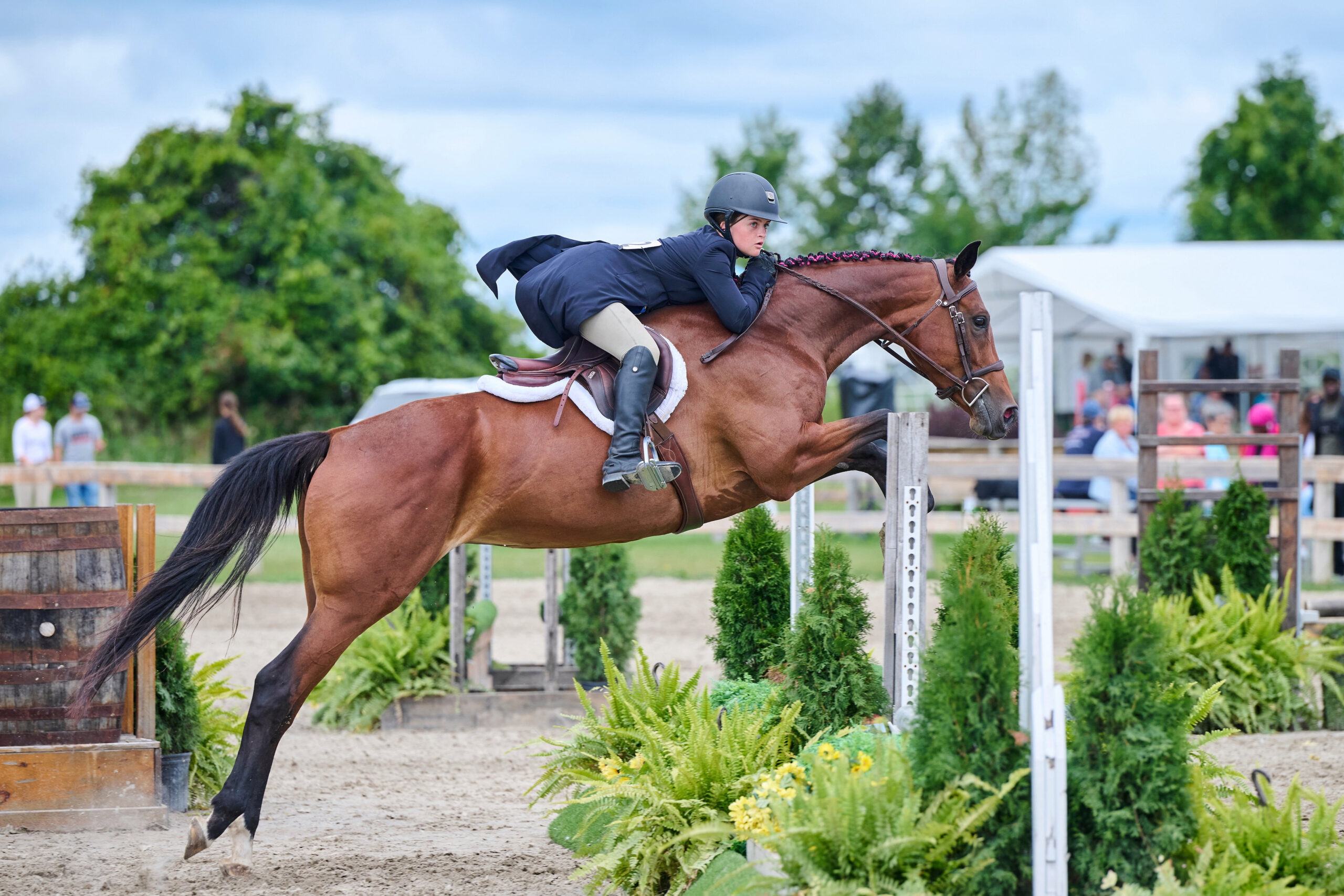accredited aftercare
All Posts & News Press Releases Success Stories Aftercare Editorials Retraining Tips Supporter Features Inspector Spotlights Humberger Toggle Menu Previous Post manhattan striker Manhattan Striker By: Alexis Arbaugh September 27, 2024 Success Stories Tags:accredited aftercare, CANTER, CANTER Michigan, Eventing, hunter jumper, Retired Racehorse Project, RRP TIP, TAKE2, Thoroughbred Aftercare Alliance, Thoroughbred Incentive Program “This has been a life-changing experience for my daughter and has shaped her in more ways beyond just in the saddle,” shared Sara Anderson. Sara Anderson and her 11-year-old daughter, Anna Huard, were searching for a horse that could become a long-term equine partner and compete in the 2018 Retired Racehorse Project (RRP). They turned to CANTER Michigan because it offered potential adopters the chance to meet and ride horses before adoption. Upon their visit, they were introduced to Manhattan Striker by CANTER Michigan’s head trainer, Jennifer Blades. Manhattan Striker, an Australian-bred black Thoroughbred gelding, had raced 23 times and earned $39,750 in Hong Kong. After his racing career ended, he was part of a group of 12 horses donated to CANTER Michigan. When Sara and Anna first met Manhattan Striker, he wasn’t the warm and affectionate horse he is today. His paperwork from the track noted that he cribbed, stall-walked, and had a generally grumpy attitude. The barn staff at Willowbrooke Farm, the facility where he was housed, had to be cautious when handling him. Despite these quirks, Sara described him as having a “serious and quiet demeanor,” which soon proved to be a great match for Anna’s personality. Manhattan Striker quickly bonded with Anna, taking an immediate liking to her. Sara observed that he seemed solid and balanced under saddle, and Anna saw potential for a long-term partnership. Although he remained grumpy during grooming, once he came home, he stopped cribbing and stall-walking altogether. He soon became sweet and affectionate with Anna and the other children at the barn. His temperament mellowed so much that he even became a suitable turnout companion for weanlings. Anna had ambitious goals for herself and Manhattan Striker, affectionately known as “Manny.” She wanted a versatile partner she could train to compete in multiple disciplines and develop a close bond with. Manny exceeded her expectations. “The retraining process was interesting,” Sara recalled. Manny wasn’t overly hot and adapted quickly to everything he was asked to do. Their goal was to enter the 2018 RRP, and Sara allowed Anna to take the lead in his training. While Manny initially lacked a lead change, he mastered it after just one lesson. “He’s been great for my daughter because she’s been able to teach him things, and he responds and learns the way you hope they will,” Sara said. Manny always tries his best and doesn’t hold a grudge if Anna makes a mistake. Through their journey together, Anna learned the value of patience and building a solid foundation with her horse. At horse shows, Manny was a dream. “No AM lounge, no hard schooling. No trainer rides, no perfect prep or ear plugs. He doesn’t even wear a martingale to mess with. Goes in a simple rubber D. He doesn’t need to see the ring before going into a class. Light warmup, a few jumps, and in he goes,” Sara wrote. Manny was also easy to load and handle at shows, and Anna could braid and prep him herself. Screenshot Although Manny isn’t the best mover, making it tough to place in hack classes, he shines as a jumper. He thrives in equitation and medal classes, excelling at technical tracks, halts, and counter-cantering. “He’s able to take the harder courses and do all the fun things,” Sara said. Anna and Manny successfully competed in the Hunter division at the 2018 RRP. They continued training and later competed in local 2’6″ Hunter classes. For a change of pace, they also enjoyed eventing. In 2022 and 2023, the pair competed in the Take2 Thoroughbred divisions and the 15-17 equitation division with notable success. Anna and Manny were named the 2023 Overall Top Junior Rider in the Take2 Hunter division and placed 9th in the Take2 Finals. “We’re also thankful for Thoroughbred-specific opportunities like the RRP, Take2, and TIP, which give kids like mine a supportive community,” Sara wrote. Manny has surpassed all the goals Anna set for him, and they have formed a strong bond along the way. Looking ahead to 2024, they plan to continue competing in the Take2 Hunter divisions and enter more equitation and medal classes during Anna’s final junior year. This past July, Anna and Manny were selected to participate in the United States Hunter Jumper Association (USHJA) Emerging Athletes Program at St. Mary-of-the-Woods College in Indiana, where Manny stood out as the only Thoroughbred. Share This Article Do you have a success story that you would like to share? Submit your experience with an accredited organization here: Success Story Submission
Read More >All Posts & News Press Releases Success Stories Aftercare Editorials Retraining Tips Supporter Features Inspector Spotlights Humberger Toggle Menu Previous Post Thoroughbred Aftercare Alliance to be Present at Laurel Park for Maryland Million Day Thoroughbred Aftercare Alliance to be Present at Laurel Park for Maryland Million Day FOR IMMEDIATE RELEASE October 8, 2024 News Tags:accredited aftercare, Laurel Park, Maryland Millon, Thoroughbred Aftercare Alliance, Thoroughbred Aftercare Alliance Race, VIP Experience LEXINGTON, KY — Thoroughbred Aftercare Alliance will be present at Laurel Park for the Jim McKay Maryland Million Day on October 12, 2024. This day is dedicated to celebrating and promoting Maryland-bred racehorses that compete in notable races, eight of which are stakes races, with purses exceeding one million dollars. The Maryland Jockey Club will honor Thoroughbred Aftercare Alliance with a named race on Maryland Million Day. After the running of the race, a presentation will be made in the winner’s circle where the winning connections will receive a Thoroughbred Aftercare Alliance gift bag and blanket. Additionally, Thoroughbred Aftercare Alliance will host the winners of the 2024 VIP Maryland Million experience from the “Off to the Races” online benefit auction. This experience was generously donated by 1/ST RACING and the Hotel at Arundel Preserve. The winners will enjoy a Clubhouse table for four at the track and a two-night stay at the Hotel at Arundel Preserve. “The Maryland Jockey Club is excited to once again welcome Thoroughbred Aftercare Alliance on Maryland Million Day,” said Georganne Hale, Vice President of Development, Maryland Jockey Club. “We are deeply committed to supporting Thoroughbreds beyond their racing careers, and we’re thrilled to promote accredited aftercare together.” About Thoroughbred Aftercare Alliance Based in Lexington, KY, Thoroughbred Aftercare Alliance is a 501(c)(3) nonprofit that accredits, inspects, and awards grants to approved aftercare organizations to retrain, retire, and rehome Thoroughbreds using industry-wide funding. Along with continued funding from its original partners Breeders’ Cup, The Jockey Club, and Keeneland Association, Thoroughbred Aftercare Alliance is supported by owners, trainers, breeders, racetracks, aftercare professionals, and other industry members. Since inception in 2012, Thoroughbred Aftercare Alliance has granted more than $31.9 million to accredited aftercare organizations. Currently 86 aftercare organizations comprised of approximately 180 facilities across North America have been granted accreditation. To learn more about Thoroughbred Aftercare Alliance, visit thoroughbredaftercare.org. Contact Thoroughbred Aftercare Alliance 859-224-2756 info@thoroughbredaftercare.org Fundraising & Events Emily Dresen 352-362-6934 edresen@thoroughbredaftercare.org Media Contact Samantha Smith Share This Release
Read More >All Posts & News Press Releases Success Stories Aftercare Editorials Retraining Tips Supporter Features Inspector Spotlights Humberger Toggle Menu Previous Post Moab’s Journey to the RRP Moab’s Journey to the RRP By: Alexis Arbaugh September 27, 2024 Retraining, Success Stories Tags:accredited aftercare, Godolphin, hunter jumper, Retired Racehorse Project, The Thoroughbred Makeover, Thoroughbred Aftercare, Thoroughbred Aftercare Alliance Moab was donated to The University of Findlay (UF) in the spring of 2023 by Godolphin, one of the world’s leading Thoroughbred breeding and racing operations. Godolphin, also a proud supporter of Thoroughbred Aftercare Alliance, is profoundly invested in the aftercare of Thoroughbreds. For years, Godolphin has supported UF’s breaking and retraining program by donating horses, highlighting their commitment to Thoroughbred aftercare. At the start of the fall semester, Ryanne, a junior in the English Equestrian Program, was assigned to work with Moab. In this program, students take full responsibility for a horse’s care and riding each semester. As they progress, students may be assigned multiple horses and are encouraged to break or retrain young horses after their freshman year. Moab, a 2020 bay gelding by Street Sense out of Skylighter, didn’t race but received some initial under-saddle training before arriving at UF. Ryanne felt relieved that she didn’t have to start from scratch, though retraining an ex-racehorse can still be challenging. Fortunately, this wasn’t Ryanne’s first experience working with a green or unbroken horse. During her sophomore year, she spent time at Findlay’s Western Farm, where she worked alongside students and trainers to break colts. Ryanne’s passion for horses began at age eight, starting with Hunter/Jumper lessons before progressing to dressage until she was 18. After high school, she enrolled at The University of Findlay and joined the English Equestrian Program, where she trained under the Hunter/Jumper coach. Most recently, Ryanne spent the summer in Wellborn, Florida, working with a variety of horses—broke, green, and unbroke—honing her skills with different levels of training. When Moab arrived at The University of Findlay, he was given time to settle into his new surroundings. By mid-August, his training with Ryanne began. Despite Moab’s calm demeanor on the ground, they approached the retraining process slowly and carefully. They worked in the detached indoor arena, where young and unbroke horses are started due to its quieter environment. Like all Findlay students, Ryanne began Moab’s training in the round pen to maintain better control. She started with lunging and eventually taught him how to line drive. Understanding the importance of forward motion in horse training, Ryanne focused on ensuring that Moab moved forward and responded to her aids, knowing that this would lay the foundation for further success. When Ryanne felt that Moab was ready to be ridden, she mounted him for the first time. Mounting can be tricky if the horse hasn’t been properly handled beforehand. To keep him calm, she had a classmate hold him while she mounted, helping Moab stay relaxed. Teaching him to stand still after mounting took time, but with patience, Moab eventually learned to wait for Ryanne’s cue to walk off. Now, mounting is easy and doesn’t faze either of them. After mounting, Ryanne’s priority was establishing forward movement and straightness. Encouraging forward motion helps the horse focus on “thinking forward” and paying attention to the rider’s aids. Straightness improves the horse’s balance and body awareness, helping them understand where all four legs are in relation to each other. These foundational elements are crucial for Moab’s training and overall responsiveness to Ryanne’s cues. While Moab’s under-saddle training progressed, Ryanne also focused on refining his ground manners. She introduced him to clippers and mane pulling, both of which he tolerated well, standing calmly during grooming sessions. They also worked on trailer loading, which he handled without any issues, further proving himself to be an all-around easy-going horse. Moab did have one quirky habit—he loved to put everything in his mouth. From blankets to Ryanne’s clothes, if it was within reach, Moab would try to chew on it. Like many young horses, this behavior stemmed from curiosity, as licking and chewing help them explore their surroundings. However, if left unchecked, it could lead to unwanted biting or nipping. Gradually, Moab began to learn that chewing on toys and treats was acceptable, but clothes—his or Ryanne’s—were off-limits. After achieving straightness, Ryanne focused on more advanced training, including teaching Moab to respond to bit pressure and use his body more efficiently. Moab excelled in these challenges, eagerly responding to Ryanne’s cues. Before long, he became strong enough to lift his back while being ridden and carry himself properly. He learned to bend and flex without losing balance, though it was more challenging for him at the trot and canter than at the walk. By taking things slow and steady, Moab was able to learn correctly, always showing a desire to do the right thing. At this stage, Ryanne recognized that Moab needed more mental stimulation. She decided to introduce ground poles as the next challenge in their preparation for the Retired Racehorse Project. Walking, trotting, and cantering over the poles didn’t bother Moab at all, so Ryanne began teaching him how to jump. Moab seemed to enjoy it, treating it like a fun game, so she continued raising the jumps and challenging him with more complex exercises and combinations. With the Retired Racehorse Project approaching, they worked diligently on lateral movements for the dressage test and perfected their 2’6″ fences for the show Hunter courses. Ryanne soon knew that Moab was ready to compete in The Retired Racehorse Project because his response time under saddle became quick and dependable. “There was no longer a conversation—I’d ask, and he’d respond with ‘yes ma’am,’” Ryanne wrote. Another sign of his readiness came when one of her classmates rode him, and Moab performed just as well for her as he did for Ryanne. It was clear that all the pieces of their training were falling into place, and Moab was fully prepared for the show. Competing at The Retired
Read More >All Posts & News Press Releases Success Stories Aftercare Editorials Retraining Tips Supporter Features Inspector Spotlights Humberger Toggle Menu Previous Post Thoroughbred Aftercare Alliance On-Site at The Retired Racehorse Project’s Thoroughbred Makeover Thoroughbred Aftercare Alliance On-Site at The Retired Racehorse Project’s Thoroughbred Makeover FOR IMMEDIATE RELEASE October 4, 2024 News Tags:accredited aftercare, Kentucky Horse Park, Retired Racehorse Project, Thoroughbred Aftercare, Thoroughbred Aftercare Alliance, Thoroughbred Makeover LEXINGTON, KY — Thoroughbred Aftercare Alliance will be on-site as a sponsor this year for The Retired Racehorse Project’s banner event, the Thoroughbred Makeover and National Symposium. The Thoroughbred Makeover takes place at the Kentucky Horse Park in Lexington, KY on October 9-12, 2024, and is the largest retraining competition for recently retired Thoroughbred racehorses. This event showcases the versatility and adaptability of these athletes as they transition into new careers, highlighting the importance of aftercare in ensuring successful second careers for Thoroughbreds. Thoroughbred Aftercare Alliance will have a booth located in the Covered Arena during the Thoroughbred Makeover. Riders and patrons are encouraged to stop by to learn more about accredited aftercare and the role it plays in the future of retired racehorses. In addition, branded merchandise will be available at the booth in exchange for donations, offering supporters a way to contribute to accredited aftercare which supports the ongoing care and retraining of these amazing Thoroughbreds. Out of the 353 horses entered in this year’s Thoroughbred Makeover, 53 horses will be representing 11 Thoroughbred Aftercare Alliance accredited organizations. These horses will be competing in 8 of the 10 disciplines offered at the event. “Thoroughbred Aftercare Alliance is thrilled to be a sponsor of The Thoroughbred Makeover,” said Stacie Clark Rogers, Operations Consultant, Thoroughbred Aftercare Alliance. “Both Thoroughbred Aftercare Alliance and The Retired Racehorse Project are deeply committed to facilitating the retraining and rehoming of these incredible athletes. The Thoroughbred Makeover is a wonderful opportunity to showcase the remarkable second careers these horses can have.” About Thoroughbred Aftercare Alliance Based in Lexington, KY, Thoroughbred Aftercare Alliance is a 501(c)(3) nonprofit that accredits, inspects, and awards grants to approved aftercare organizations to retrain, retire, and rehome Thoroughbreds using industry-wide funding. Along with continued funding from its original partners Breeders’ Cup, The Jockey Club, and Keeneland Association, Thoroughbred Aftercare Alliance is supported by owners, trainers, breeders, racetracks, aftercare professionals, and other industry members. Since its inception in 2012, Thoroughbred Aftercare Alliance has granted more than $31.9 million to accredited aftercare organizations. Currently, 86 aftercare organizations comprised of approximately 180 facilities across North America have been granted accreditation. To learn more about Thoroughbred Aftercare Alliance, visit thoroughbredaftercare.org. Contact Thoroughbred Aftercare Alliance 859-224-2756 info@thoroughbredaftercare.org Fundraising & Events Emily Dresen 352-362-6934 edresen@thoroughbredaftercare.org Media Contact Samantha Smith Share This Release
Read More >All Posts & News Press Releases Success Stories Aftercare Editorials Retraining Tips Supporter Features Inspector Spotlights Humberger Toggle Menu Previous Post Thoroughbred Aftercare Alliance On-Site at Santa Anita Park for California Crown Thoroughbred Aftercare Alliance On-Site at Santa Anita Park for California Crown FOR IMMEDIATE RELEASE September 18, 2024 News Tags:1ST, accredited aftercare, Best Turned Out, Best Turned Out awards, California Crown, LRF Cares, Santa Anita, Santa Anita Park, Thoroughbred Aftercare Alliance LEXINGTON, KY — Thoroughbred Aftercare Alliance will be on-site at Santa Anita Park on Saturday, September 28, 2024, for the inaugural California Crown. California Crown Day is headlined by the $1,000,000 California Crown (G1) at 1 1/8 miles on the Santa Anita main track. The California Crown is also a “Win and You’re In” race for the LONGINES Breeders’ Cup Classic that will be contested on November 2. California Crown day will offer more than $3 million in elevated purses, including the $750,000, California Crown John Henry Turf Championship (G2) presented by 1/ST BET, the $750,000, California Crown Eddie D Stakes (G2) presented by FanDuel, the $200,000, City of Hope Mile Stakes (G2) presented by MyRacehorse and the $100,000 Unzip Me Stakes presented by Thoroughbred Aftercare Alliance. Following the running of the $100,000 Unzip Me Stakes presented by Thoroughbred Aftercare Alliance, winning connections will be presented with a Thoroughbred Aftercare Alliance branded blanket and gift bag in the winner’s circle. A check presentation will be made from 1/ST to Thoroughbred Aftercare Alliance also following the running of the Thoroughbred Aftercare Alliance race. “We’re excited to host the inaugural California Crown and partner with Thoroughbred Aftercare Alliance to highlight accredited aftercare,” said Nate Newby, General Manager, Santa Anita Park. “This event spotlights the best of California racing, and collaborating with Thoroughbred Aftercare Alliance provides a great opportunity for race fans and participants to learn more about the mission to support Thoroughbreds after racing.” Thoroughbred Aftercare Alliance will present the Best Turned-Out awards for all six stakes races at Santa Anita, including the Thoroughbred Aftercare Alliance race. Additionally, all undercard Best Turned-Out winners will receive gift bags from Thoroughbred Aftercare Alliance, with awards also being given to three outriders. The Best Turned-Out awards are generously sponsored by LRF Cares. “Thoroughbred Aftercare Alliance is thrilled to be part of the inaugural California Crown,” said Emily Dresen, Director of Funding & Events. “Presenting the Best Turned Out awards with LRF Cares is a great way to showcase the importance of horse care both before and after the track.” About Thoroughbred Aftercare Alliance Based in Lexington, KY, Thoroughbred Aftercare Alliance is a 501(c)(3) nonprofit that accredits, inspects, and awards grants to approved aftercare organizations to retrain, retire, and rehome Thoroughbreds using industry-wide funding. Along with continued funding from its original partners Breeders’ Cup, The Jockey Club, and Keeneland Association, Thoroughbred Aftercare Alliance is supported by owners, trainers, breeders, racetracks, aftercare professionals, and other industry members. Since inception in 2012, Thoroughbred Aftercare Alliance has granted more than $31.9 million to accredited aftercare organizations. Currently 86 aftercare organizations comprised of approximately 180 facilities across North America have been granted accreditation. To learn more about Thoroughbred Aftercare Alliance, visit thoroughbredaftercare.org. Contact Samantha Smith859-224-2882ssmith@thoroughbredaftercare.org Emily Dresen352-362-6934edresen@thoroughbredaftercare.org Share This Release
Read More >All Posts & News Press Releases Success Stories Aftercare Editorials Retraining Tips Supporter Features Inspector Spotlights Previous Post Thoroughbred Aftercare Alliance to be Present at Colonial Downs for Virginia Derby Day Thoroughbred Aftercare Alliance to be Present at Colonial Downs for Virginia Derby Day FOR IMMEDIATE RELEASE September 5, 2024 News Tags:accredited aftercare, Best Turned Out, Colonial Downs, Kitten’s Joy Stakes, Thoroughbred Aftercare Alliance, VIP, virginia Derby Day LEXINGTON, KY — Thoroughbred Aftercare Alliance will be present at Colonial Downs Racetrack during the weekend of the $500,000 New Kent County Virginia Derby, set for Saturday, September 7, 2024. The Virginia Derby is a Grade III race that covers 1 1/8 miles on the turf. Colonial Downs, a longtime supporter of accredited aftercare, will honor Thoroughbred Aftercare Alliance with a named race on the Virginia Derby Day. Thoroughbred Aftercare Alliance will present Race # 7, the Grade III $125,000 Kitten’s Joy Stakes, which is a 1 1/16-mile turf race that is set to run at 4:20 PM ET. Following the race, a presentation will take place in the winner’s circle, where the connections will receive a Thoroughbred Aftercare Alliance branded gift bag and blanket. On Saturday, Thoroughbred Aftercare Alliance will present Best Turned-Out awards for all six stakes races at Colonial Downs, including the Virginia Derby and the Thoroughbred Aftercare Alliance Kitten’s Joy Stakes. The Best Turned-Out awards are generously sponsored by Virginia HBPA. Additionally, a representative from Thoroughbred Aftercare Alliance will be present to host the winners of the “Off to the Races” VIP Experience online benefit auction. This exciting VIP experience was donated by Colonial Downs. The winners will enjoy a table for six at the 1609 Restaurant, paddock passes and winners circle access for the Thoroughbred Aftercare Alliance Kitten’s Joy Stakes, and much more. “I’m both excited and grateful to represent Thoroughbred Aftercare Alliance at Colonial Downs on Virginia Derby Day,” said Suzie Picou-Oldham, Inspections Administrator, Thoroughbred Aftercare Alliance. “We will be presenting Best Turned-Out awards, sponsored by Virginia HBPA. This is a fantastic way for us to celebrate accredited aftercare while awarding the grooms who care for the horses on the track.” About Thoroughbred Aftercare Alliance Based in Lexington, KY, Thoroughbred Aftercare Alliance is a 501(c)(3) nonprofit that accredits, inspects, and awards grants to approved aftercare organizations to retrain, retire, and rehome Thoroughbreds using industry-wide funding. Along with continued funding from its original partners Breeders’ Cup, The Jockey Club, and Keeneland Association, Thoroughbred Aftercare Alliance is supported by owners, trainers, breeders, racetracks, aftercare professionals, and other industry members. Since inception in 2012, Thoroughbred Aftercare Alliance has granted more than $31.9 million to accredited aftercare organizations. Currently 86 aftercare organizations comprised of approximately 180 facilities across North America have been granted accreditation. To learn more about Thoroughbred Aftercare Alliance, visit thoroughbredaftercare.org. Contact Samantha Smith 859-224-2882 ssmith@thoroughbredaftercare.org Emily Dresen 352-362-6934 edresen@thoroughbredaftercare.org Share This Release
Read More >All Posts & News Press Releases Success Stories Aftercare Editorials Retraining Tips Supporter Features Inspector Spotlights Previous Post the long road home The Long Road Home By: Alexis Arbaugh August 22, 2024 Success Stories Tags:accredited aftercare, Accredited Facility, Caribbean Thoroughbred Aftercare, Success story, Trail Ridig Lora Eike was familiar with Caribbean Thoroughbred Aftercare (CTA) as she had previously adopted a 2009 grey gelding, Crafty Noble, in 2019. In 2022, Lora was enlisted to help a friend find an off-the-track Thoroughbred, so she reached out to Kelley Stobie, Co-Founder, Secretary, and Executive Director of CTA. Lora’s friend was looking for a horse suitable for a 13-year-old girl in a training program. Kelley recommended Trust in Russ, a 2015 Kentucky-bred dark bay gelding. In his four-year career from 2018 to 2022, Trust in Russ had 71 starts and earned $68,731. Lora’s friends decided to adopt a different Thoroughbred from CTA, which left Trust in Russ open for adoption. Kelley was adamant that Trust in Russ (Rico) would have been perfect for a 13-year-old girl because of his kind and sweet nature. “I knew he had to be good, and so I wanted him for myself,” Lora wrote. Lora planned to ship Rico from Puerto Rico to the Blue Ridge Mountains in Virginia. Unfortunately, during his layover in Ocala, Florida, he ran into a fence and injured himself badly. “He is doing amazing now,” Lora wrote. After getting him home to Virginia and healing from his injuries, Rico is a happy and healthy horse. Rico spends his days “living his best life” by taking inexperienced riders through the mountains of Virginia. He takes perfect care of everyone who rides him and is “truly a gem and a complete gentleman.” Lora is immensely grateful for CTA and all that they did for Rico so that she can care for and love him for the rest of his life. “From the flight to Miami and the vet bills from the injury at the layover barn, I’d like you to know that this horse is worth every penny spent, and a whole lot more,” Lora wrote. Share This Article Do you have a success story that you would like to share? Submit your experience with an accredited organization here: Success Story Submission
Read More >All Posts & News Press Releases Success Stories Aftercare Editorials Retraining Tips Supporter Features Inspector Spotlights Previous Post Thoroughbred Aftercare Alliance to Highlight Initiatives in Saratoga Thoroughbred Aftercare Alliance to Highlight Initiatives in Saratoga FOR IMMEDIATE RELEASE July 24, 2024 News Tags:accredited aftercare, Accredited Organizations, Fasig Tipton, Fasig-Tipton Sales, NYRA, Saratoga Race Course, Thoroughbred Aftercare Alliance, Whitney Stakes LEXINGTON, KY — Thoroughbred Aftercare Alliance will return to Saratoga this August to highlight accredited aftercare with a variety of initiatives at Saratoga Race Course and Fasig-Tipton. Thoroughbred Aftercare Alliance will be present for both the weekend of the Grade 1, $1 million Whitney Stakes, and the following week of the Fasig-Tipton Selected Yearling sales. New York Racing Association, Inc. (NYRA) will feature Thoroughbred Aftercare Alliance as its Community Partner during the weekend of the Whitney Stakes. The 97th running of the Whitney Stakes will be held at Saratoga Race Course on Saturday, August 3, 2024. Thoroughbred Aftercare Alliance will be present at NYRA’s Community Outreach Booth on both Saturday and Sunday, where patrons and race fans can visit to learn about accredited aftercare. Branded merchandise will also be available at the booth in exchange for a donation, including a limited-edition Thoroughbred Aftercare Alliance ‘Saratoga’ t-shirt. During the weekend of the Whitney Stakes, Thoroughbred Aftercare Alliance will be honored with a named race on Saturday’s undercard. After the named race, a presentation will be made to the winning connections, including a branded blanket and branded merchandise. Additionally, representatives from Thoroughbred Aftercare Alliance will present the Best Turned Out Horse award on Saturday during the Fasig-Tipton Lure in the winner’s circle. Thoroughbred Aftercare Alliance will host the winners of the Saratoga VIP Experience from the “Off to the Races” online benefit auction. This experience was generously donated by NYRA, the National Museum of Racing and Hall of Fame, and Anne’s Washington Inn. The winners will enjoy a horseman’s box for five, paddock and winner’s circle access for the Thoroughbred Aftercare Alliance race, a tour with Tom Durkin at the National Museum of Racing and Hall of Fame, and much more. Fasig-Tipton, another supporting partner of Thoroughbred Aftercare Alliance, is set to hold The Saratoga Sale featuring selected yearlings on August 5-6. Thoroughbred Aftercare Alliance representatives will be on-site to converse with consigners, buyers, and supporters to discuss accredited aftercare. In addition, Thoroughbred Aftercare Alliance will hand out New York Thoroughbred Breeding & Development Fund co-branded rub rags to consigners of the New York Bred Yearlings Sale, which will be held August 11-12. “We are very excited to once again participate in so many industry events and spread awareness for accredited aftercare while we are at the NYRA Saratoga race meet,” said Stacie Clark Rogers, Operations Consultant, Thoroughbred Aftercare Alliance. “It’s wonderful to connect with supporters and partners during the race meet and the Fasig-Tipton Sale and to visit and meet with many of our New York accredited organizations.” While in Saratoga, Thoroughbred Aftercare Alliance will visit accredited aftercare facilities to conduct inspections as part of the accreditation process. Staff will also meet with trainers, owners, and other supporters throughout the week to discuss accredited aftercare. Thoroughbred Aftercare Alliance board members will convene for an annual board meeting on Thursday, August 8. About Thoroughbred Aftercare Alliance Based in Lexington, KY, Thoroughbred Aftercare Alliance is a 501(c)(3) nonprofit that accredits, inspects, and awards grants to approved aftercare organizations to retrain, retire, and rehome Thoroughbreds using industry-wide funding. Along with continued funding from its original partners Breeders’ Cup, The Jockey Club, and Keeneland Association, Thoroughbred Aftercare Alliance is supported by owners, trainers, breeders, racetracks, aftercare professionals, and other industry members. Since inception in 2012, Thoroughbred Aftercare Alliance has granted more than $31.9 million to accredited aftercare organizations. Currently 86 aftercare organizations comprised of approximately 180 facilities across North America have been granted accreditation. To learn more about Thoroughbred Aftercare Alliance, visit thoroughbredaftercare.org. Contact Samantha Smith 859-224-2882 ssmith@thoroughbredaftercare.org Emily Dresen 352-362-6934 edresen@thoroughbredaftercare.org Share This Release
Read More >All Posts & News Press Releases Success Stories Aftercare Editorials Retraining Tips Supporter Features Inspector Spotlights Previous Post finally home for burning bluegrass Finally Home For Burning Bluegrass By: Alexis Arbaugh June 7, 2024 Success Stories Tags:accredited aftercare, Barrel Racing, Racing For Home Inc., Success story Alana with her distinctive leopard top and Kitten navigating a barrel Racing For Home Inc., a Thoroughbred Aftercare Alliance-accredited organization, recently shared a heartwarming success story. It all began when they discovered a large group of horses for auction in Ohio. While most had found homes through various aftercare groups, two mares, Burning Bluegrass and Simply Belonging, were still in need. Despite space constraints, Racing For Home Inc. decided to take them both in, hopeful for their future. Fortunately, they had the support of Nacho Barron, a compassionate farrier who agreed to temporarily host the mares on his farm. “Our wonderful farrier Nacho Barron was willing to hold the horses at his farm until we could place them,” said Racing For Home Inc. Soon after giving the horses their well-deserved letdown period on his farm, Racing For Home Inc. successfully adopted out Simply Belonging to a family in Rhode Island who by chance also had her half-brother. However, finding a suitable home for Burning Bluegrass proved more challenging. Another aftercare group initially took her in, hoping to use her in their training program. She was a great lesson horse, and eventually, one of the students offered to give her a good home. However, the girl was not prepared for the amount of work training and owning a horse full-time was, so Burning Bluegrass was returned to the organization and ultimately ended back at Racing For Home Inc. Nacho Barron with Burning Bluegrass “Kitten” and her rider Alana (right). Alana with New Hampshire Championship Once again, Nacho Barron extended his kindness, offering to integrate Burning Bluegrass into his lesson program. Renamed “Kitten,” she thrived under his care, particularly excelling as a barrel horse for his student, Alana Riendeau. Their partnership blossomed, with Kitten and Alana steadily climbing the ranks in barrel competitions, culminating in their victory at the New Hampshire 4D Championship. Their success garnered attention, with Alana donning a leopard print top in honor of her horse’s name, while Kitten sported leopard bell boots. At a recent competition in Syracuse, the PA announcer added a playful touch by introducing them with a “meow” sound after each entry, much to the delight of the crowd. The journey of Burning Bluegrass, now affectionately known as Kitten, serves as a testament to the perseverance and transformative bond between horse and rider. Thanks to the commitment of Racing For Home Inc. and the unwavering support of Nacho Barron, Kitten found her forever home and continues to shine in the competitive arena alongside her dedicated partner, Alana Riendeau. Share This Article Do you have a success story that you would like to share? Submit your experience with an accredited organization here: Success Story Submission
Read More >All Posts & News Press Releases Success Stories Aftercare Editorials Retraining Tips Supporter Features Inspector Spotlights Previous Post Let’s Get It Did Let’s Get It Did By: Alexis Arbaugh June 7, 2024 Success Stories Tags:accredited aftercare, hunters, jumpers, LongRun Thoroughbred Retirement Society, Success story After riding and competing on ponies, Camden Conway was ready to step up to a horse. After a lot of thinking, Camden’s father concluded that adopting a horse would be the best course of action to find Camden a new horse. In 2021, Camden received her new horse as a Christmas present. Let’s Get It Did is a 2018 bay mare who ran a total of 3 times at Woodbine Racetrack. Camden’s father adopted her from LongRun Thoroughbred Retirement Society in Toronto, Ontario, Canada. Let’s Get It Did is now affectionately known as Diddy. Camden’s father was delighted that the mare “jumped over the 4-foot fence” when he arrived at LongRun. He had actually planned on adopting a different horse more suitable to what Camden needed but ultimately, he was amazed by the scope and athleticism of Diddy, so he adopted Diddy instead. Shortly after bringing home Diddy, Camden and Diddy competed in their first show where they rode in the walk/trot cross rail division. The pair did well, placing 1st in the equitation over fences, 4th in the equitation under saddle, and 6th in the hunter under saddle. Their next competition was a Silver Series show where they entered in the 0.60 and 0.70-meter jumpers. This was before Camden realized that Diddy needed more jump underneath her for her to make an effort over the jumps – the small jumps were too easy for her. For their last Silver Series Show, Camden and Diddy were entered in the 0.80-0.90 classes to encourage her “to actually pick up her feet,” wrote Camden. The pair placed in every 0.80 class and received 3rd and 8th out of a large group in the 0.90-meter. After many jumper shows, Diddy seemed to settle in nicely to the horse show life. Camden believed that she was ready to compete in a hunter derby. “She completely exceeded both my and my coach’s expectations as she got an 84 in the 2’6/2’9 derby which got her 4th in the class,” wrote Camden. Camden has her eyes set on a bright future with Diddy. She hopes to show in the 1.00 and 1.10-meter next show season. Camden wants Diddy to be the horse that she can “move up the heights with.” The 1.10 Grand Prix in the Silver Series is one of their goals. She also hopes to “get her into some jumper medals as well as the 3’/3’3 derbies for fun,” Camden wrote. Another goal for them is to compete in the Thoroughbred jumper classes and the U25 jumper classes that are on the Gold circuit. Share This Article Do you have a success story that you would like to share? Submit your experience with an accredited organization here: Success Story Submission
Read More >





